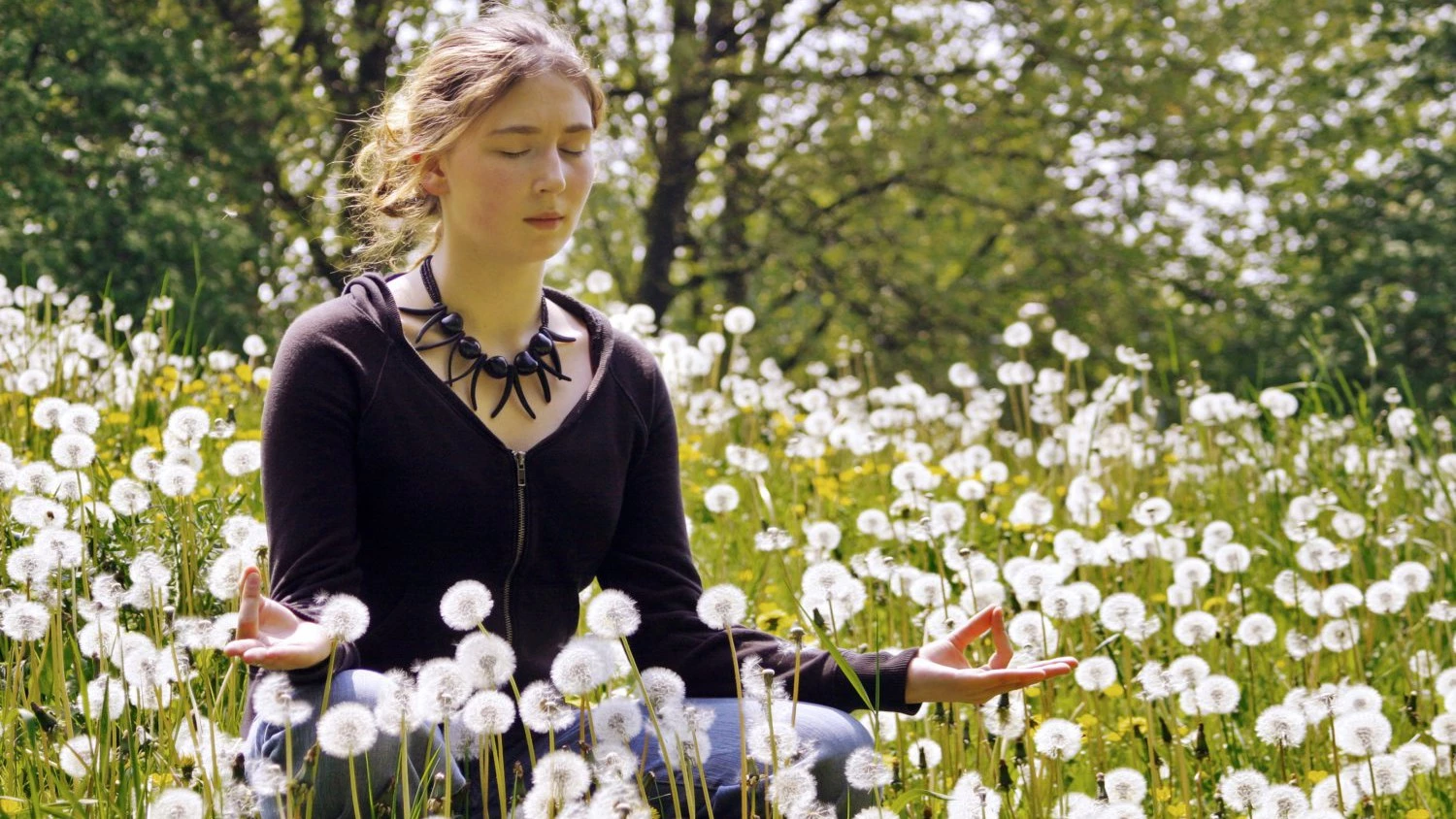How Equanimity from Yoga Helps Us Live in Grace

In the summer of 1991 my good friend, Scott, began the process of dying of AIDS. A few months before Scott fell ill, I had taken a job and moved to his town, Boulder, Colorado. In the months before I arrived, Scott and I spoke several times on the phone, speculating about things we would do together—musical outings, hikes, walks around the Pearl Street mall. As the summer, and Scott’s illness, progressed, the nature of our outings together became more pedestrian—trips to the grocery store, visits to the hospital, meals at his apartment—and our conversations became more serious.
Applying the Lessons of Yoga in Life
At the time I had been practicing yoga for ten years and had spent five years independently studying diet and nutrition. Scott probed me for information about how he could stay healthy and boost his immune system and while I offered all I knew, it was too little and way too late. I felt frustrated at my inability to help him and often felt that somehow I could have helped him live longer or more comfortably if only I had more knowledge to share.
After his death later that year, I often reminisced fondly about my friend, but the remembrances were colored with nagging regret that I had not done enough. About a year after his passing, Scott’s image appeared one day during my meditation practice. A more spacious perspective allowed me to see that I really had done all I could do for him simply by being his friend. I saw that his path—like all our paths—was his own to travel and that his life played itself out in the only way it could have given the choices he had made. I saw that it was not my place to try to “save” him, and that the friendship and support I had offered were indeed of great value to his life and to mine.
The realization helped me to understand his journey from a much wider perspective than my ego’s limited viewpoint. There was no reason to judge Scott‘s path as being either tragic or triumphant. It was simply his path. From this greater understanding I was able to honor his life more fully. My good wishes for his health and well-being were indeed helpful for him and for me, but they could not alter the course of his life.
A few years later I learned that the ability to respect and honor the paths of others is a component of the great quality of equanimity. Equanimity, or upekkha in Pali language, is described in Buddhist psychology as an ”unshakable balance” in the face of life’s vicissitudes.
Equanimity is the last of the four brahma viharas (translated from Pali language as “divine abodes”). These qualities are referenced in Patanjali’s Yoga Sutras in Sutra 1.33: “The mind becomes serene and clear when the qualities of the heart are cultivated: friendliness toward the joyful, compassion toward the suffering, happiness toward the pure, and impartiality toward the impure.” (This is from Alistair Shearer’s translation.) Sutra 2.48, one of the three sutras that address asana, claims that was our asana practice deepens “we are no longer upset by the play of opposites” in our lives. Clearly equanimity is woven into the practices of yoga.
Owning Your Karma: Developing Equanimity in Our Lives
The traditional phrase for developing equanimity, said to oneself in meditation is, “All beings are the owners of their karma. Their happiness or unhappiness depends on their actions, not on my wishes for them.” While this phrase might seem to indicate a quality of indifference, equanimity comes not from disconnecting from or ignoring difficult situations, but from openness and full acceptance of what is present, whether it is pleasant or unpleasant. It springs from the understanding that happiness depends not on outer circumstances but rather on our inner response to what is happening. I cared deeply about Scott and the quality of his life, but I came to understand that in order to honor him fully I had to accept the absolute rightness of his path.
As children grow to adulthood, parents learn this form of gracious acceptance. Parents may not agree with choices their children make, but equanimity helps them to trust the unfolding of their children’s lives. One may wish his/her children well, but must recognize that their decisions are their own to make. This does not mean the parent no longer cares for the child’s well-being. The ability to let go of the need to control a child’s life comes from profound love and wisdom. This surrender brings great freedom to the child and to the parent.
The traditional metaphor for equanimity is the image of a mountain. All manner of weather conditions are cast upon a mountain—rains, winds, beating sun—yet it remains unharmed. The mountain absorbs all that comes to it. In the same way, the quality of equanimity allows us to accept and absorb all that happens in our lives without preference.
It is the nature of our lives that we experience all things—pleasure and pain, gain and loss, praise and blame, fame and disrepute. We have largely been conditioned to grasp at that which feels pleasant and to shrink away from that which feels unpleasant. While these responses might seem natural and wise, they can cause us to feel tossed about from one extreme to the other. Developing equanimity can help us to arrest the wild movements of the mind so that we can absorb what comes to us and learn to understand our lives more deeply.
Meditation teacher and author Jack Kornfield calls equanimity a “radical acceptance of life.” He believes equanimity comes from learning to be comfortable with not knowing. Most of the time we do not really know what the final outcome of any situation in our lives will be. Many times situations we enjoy in the moment have unhappy consequences later on, or situations that seem difficult in the moment bring us to greater wisdom and happiness. Equanimity helps us to trust the unfolding of our lives whether what is happening to us is pleasant or unpleasant.
It can be helpful to reflect on your life and the events that led you to where you are now. Remember the circumstances that seemed difficult at the time and those that brought happiness. Reflect on how all the events of your life have contributed to the person you are in this moment. Reflecting in this way can help us see how our lives do not unfold randomly—our actions connect intimately to each other and to the present conditions in our lives. Be careful not to make judgments about your choices. Consider instead how logically and appropriately you have arrived where you are today.
Equanimity, like the other brahma viharas, is a quality that is intrinsic to all of us. It resides at the core of our being, and while past conditioning and learned coping strategies may sometimes obscure equanimity it is a quality that can be practiced. Practices such as meditation and yoga can help us uncover the radiant quality of upekkha. Equanimity arises naturally as a result of mindfulness meditation practice. In the process of examining and accepting our fluctuating thoughts and emotions, we become better equipped to meet all the experiences of our lives with a balanced mind.
How to Practice Equanimity
The formal meditative practice of equanimity is similar to the practices of the other brahma viharas. We practice by repeating phrases that create the intention of opening the space for equanimity to develop. The traditional phrase is the one mentioned above, but it is fine to explore using other phrases as well.
In a comfortable sitting position, close your eyes and begin by repeating silently either the above equanimity phrase or any of the following: “May we accept all things as they are,” or “May we be undisturbed by the joys and sorrows of our lives” or “Joys and sorrows arise and pass in accordance with natural law” or simply, “Things are as they are.” It may be appropriate to make up your own phrases. What is most important is that what you say has meaning for you.
Developing equanimity, like any other skill, does take practice. Often when we place our intention in learning a skill, we begin to see more clearly how often we are not where we would like to be. It takes time to change a deeply held habit. It is helpful to suspend self-judgment when you observe yourself behaving reactively at times. Over time, with practice, habits can shift. Being patient with yourself not only makes the journey more pleasant; it also helps develop equanimity.
The ability to greet the ups and downs of our lives with the great balancing quality of equanimity helps us to live peacefully and happily. It allows us to radiate calm that provides ballast in our lives and the lives of those around us. With equanimity as our ground, we live in grace.
More on equanimity from YogaUOnline and Christine Malossi: Open to What May Come – Moving Beyond Expectations.
Study with YogaUOnline and Robin Rothenberg: Yoga for Stress Relief: Ancient Pathways for Creating Greater Resilience, Courage, and Equanimity.
 Charlotte Bell began practicing yoga in 1982 and began teaching in 1986. She was certified by B.K.S. Iyengar in 1989 following a trip to Pune. In 1986, she began practicing Insight Meditation with her mentors Pujari and Abhilasha Keays. Her asana classes blend mindfulness with physical movement. Charlotte writes a column for Catalyst Magazine and serves as editor for Yoga U Online. She is the author of two books: Mindful Yoga, Mindful Life and Yoga for Meditators, both published by Rodmell Press. She also edits Hugger Mugger Yoga Products¹ blog and is a founding board member for GreenTREE Yoga, a non-profit that brings yoga to underserved populations. A lifelong musician, she plays oboe and English horn in the Salt Lake Symphony and the folk sextet Red Rock Rondo whose 2010 PBS music special won two Emmys.
Charlotte Bell began practicing yoga in 1982 and began teaching in 1986. She was certified by B.K.S. Iyengar in 1989 following a trip to Pune. In 1986, she began practicing Insight Meditation with her mentors Pujari and Abhilasha Keays. Her asana classes blend mindfulness with physical movement. Charlotte writes a column for Catalyst Magazine and serves as editor for Yoga U Online. She is the author of two books: Mindful Yoga, Mindful Life and Yoga for Meditators, both published by Rodmell Press. She also edits Hugger Mugger Yoga Products¹ blog and is a founding board member for GreenTREE Yoga, a non-profit that brings yoga to underserved populations. A lifelong musician, she plays oboe and English horn in the Salt Lake Symphony and the folk sextet Red Rock Rondo whose 2010 PBS music special won two Emmys.



